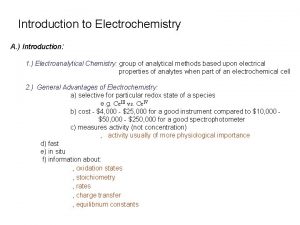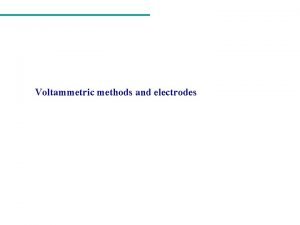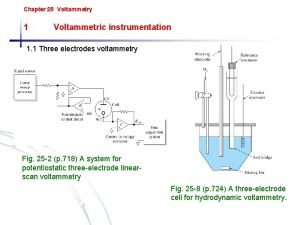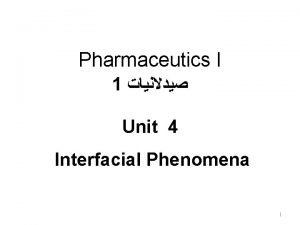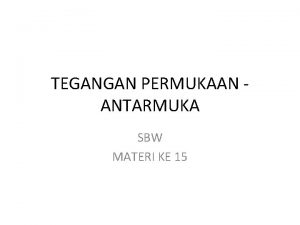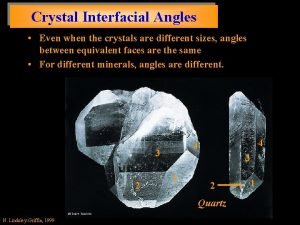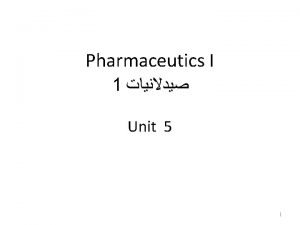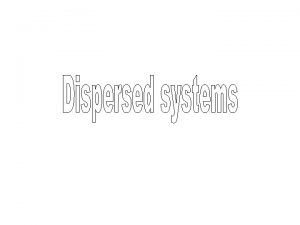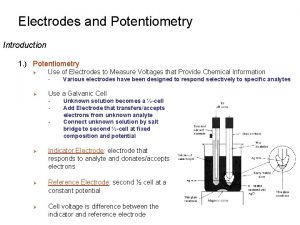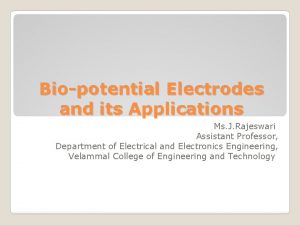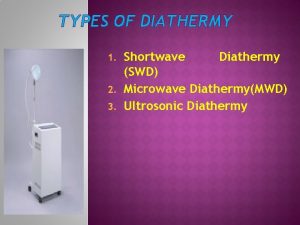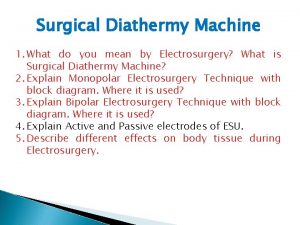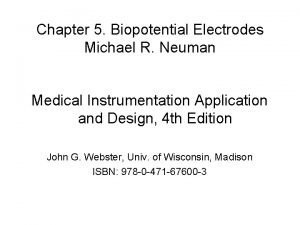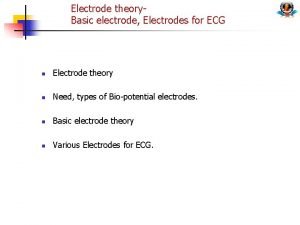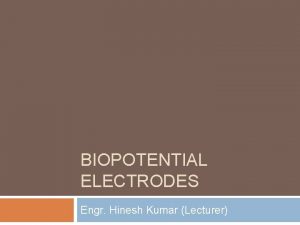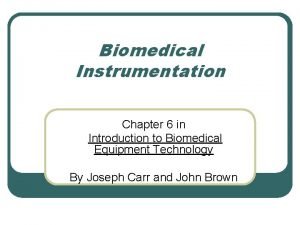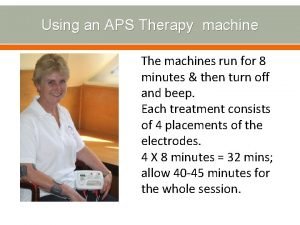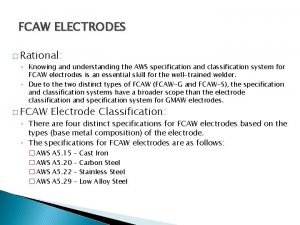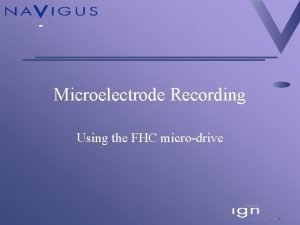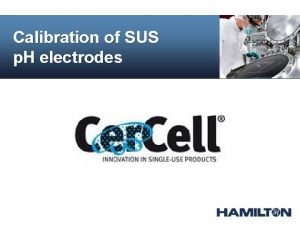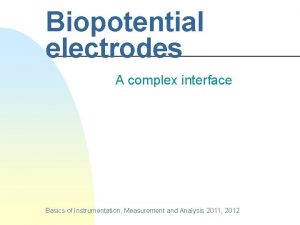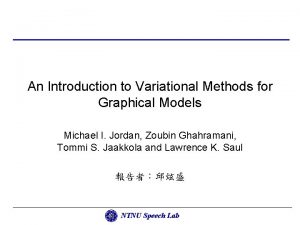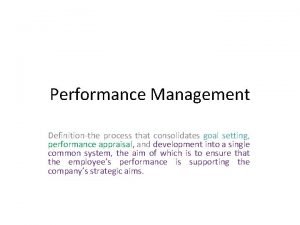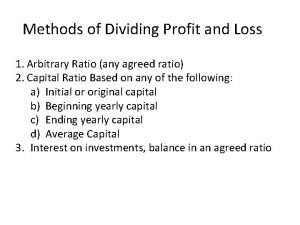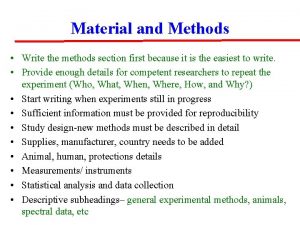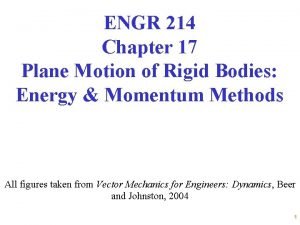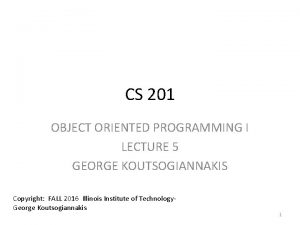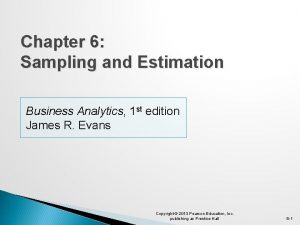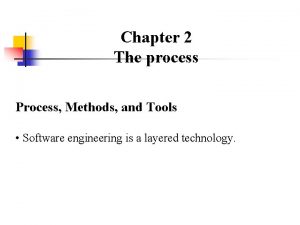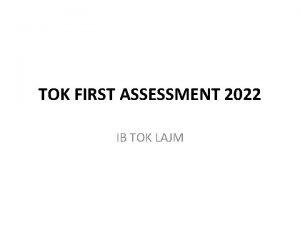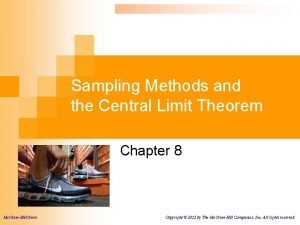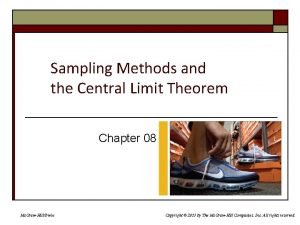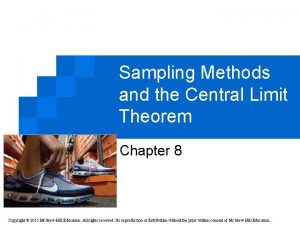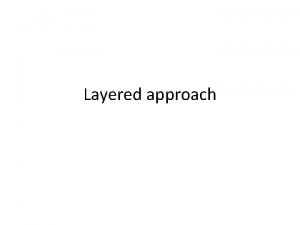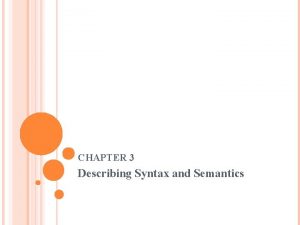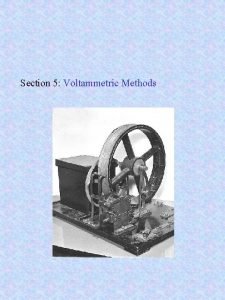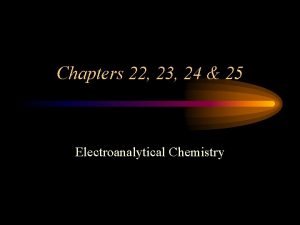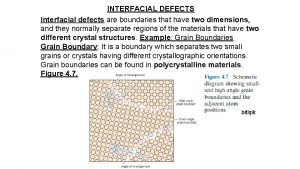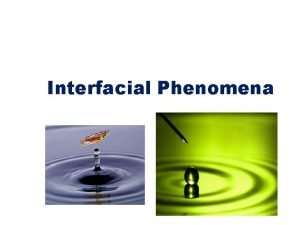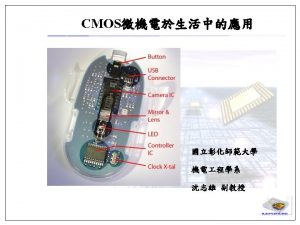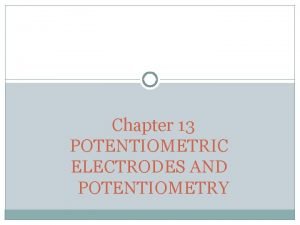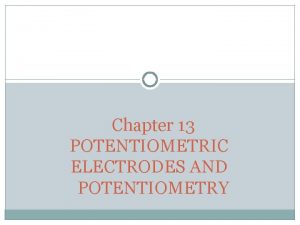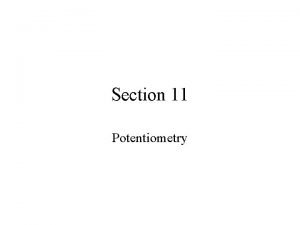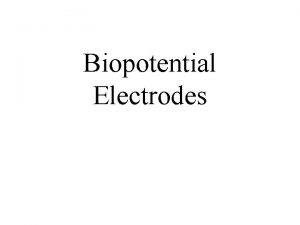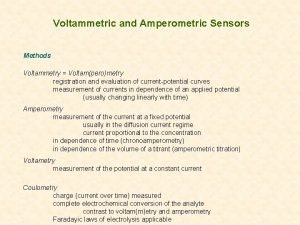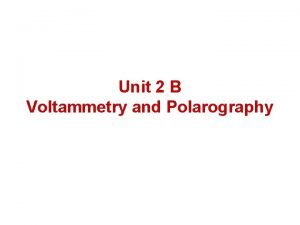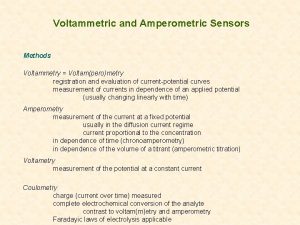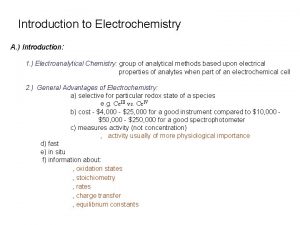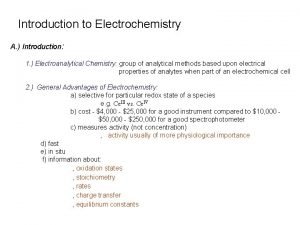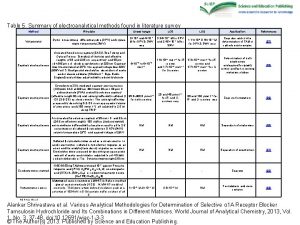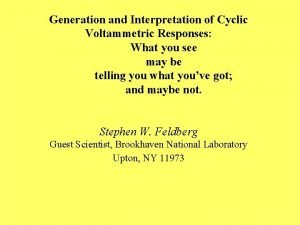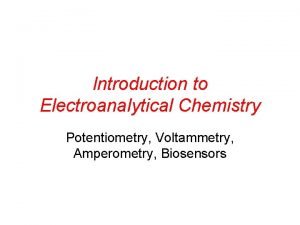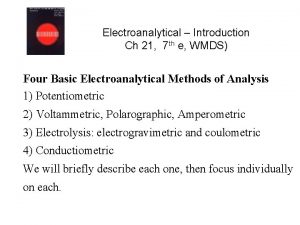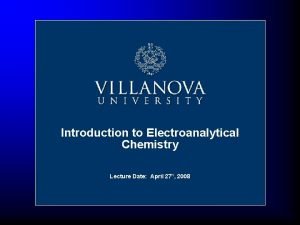Voltammetric methods and electrodes Introduction Electroanalytical methods Interfacial





![Nernst Equation E = Eo + 0. 0592/n + log [ox]/[red] Fe 3+ + Nernst Equation E = Eo + 0. 0592/n + log [ox]/[red] Fe 3+ +](https://slidetodoc.com/presentation_image/349438ad37e31581b1eda35581797a0a/image-6.jpg)











































































- Slides: 81

Voltammetric methods and electrodes

Introduction Electroanalytical methods Interfacial methods Static methods I~0 Potentiometry (E) Const. electrode potential coulometry (Q = ∫ 01 idt Bulk methods Dinamic methods I#0 Conductometry (G = 1/R) Potentiometric titrations (volume) Controlled potential Voltammetry [ I = f (E) ] Conductometric Titrations (volume) Constant current Coulometric Titrations (Q = It) Electrogravimetry (wt) Amperometric titrations (volume) Electrogravimetry (wt)

Five Important interrelated concepts to understand electrochemistry: (1) the electrode’s potential determines the analyte’s form at the electrode’s surface; (2) the concentration of analyte at the electrode’s surface may not be the same as its concentration in bulk solution; (3) in addition to an oxidation–reduction reaction, the analyte may participate in other reactions; (4) current is a measure of the rate of the analyte’s oxidation or reduction; and (5) we cannot simultaneously control current and potential. L. Faulkner, Understanding electrochemistry: some distinctive concepts, ” J. Chem. Educ. , 60, 262 (1983) ; P. T. Kissinger, A. W. Bott, Electrochemistry for the Non. Electrochemist, ” Current Separations, 20, 51 (2002)

1) The Electrode’s Potential Determines the Analyte’s Form Fig. Redox ladder diagram for Fe 3+/Fe 2+ and for Sn 4+/ Sn 2+ redox couples. The areas in blue show the potential range where the oxidized forms are the predominate species; the reduced forms are the predominate species in the areas shown in pink. Note that a more positive potential favors the oxidized forms. At a potential of +0. 500 V (green arrow) Fe 3+ reduces to Fe 2+, but Sn 4+ remains unchanged.

2) Interfacial Concentrations May Not Equal Bulk Concentrations Fig. Concentration of Fe 3+ as a function of distance from the electrode’s surface at (a) E = +1. 00 V and (b) E = +0. 500 V. The electrode is shown in gray and the solution in blue.
![Nernst Equation E Eo 0 0592n log oxred Fe 3 Nernst Equation E = Eo + 0. 0592/n + log [ox]/[red] Fe 3+ +](https://slidetodoc.com/presentation_image/349438ad37e31581b1eda35581797a0a/image-6.jpg)
Nernst Equation E = Eo + 0. 0592/n + log [ox]/[red] Fe 3+ + e Fe 2+ E = Eo + 0. 0592/1 + log [Fe 3+]/[Fe 2+] 3) The Analyte May Participate in Other Reactions Fe 3+ + OH- Fe. OH 2+

4) We Cannot Simultaneously Control Both Current and Potential 5) Controlling and Measuring Current and Potential






Controlled Potential Methods (Voltammetry)

Fig. Flow patterns and regions of interest near the work electrode in hydrodynamic voltammetry


Controlled Potential Methods (Voltammetry) O + ne R E = Eo` + 0. 0592/n + log Cs. O / Cs. R (1) (2) where E = potential applied to electrode (m. V) Eo`= formal reduction potential of the couple vs Eref n = number of electrons in reaction (1) Cs. O = surface concentration of species O Cs. R = surface concentration of species R

Table. Relationship of E to surface concentrations# E, m. V Cs. O / Cs. R 236 10, 000/1 177 1, 000/1 118 100/1 59 10/1 0 1/1 -59 1/10 -118 1/100 -177 1/1, 000 -236 1/10, 000 For a reversible system, n = 1, Eo`= V


The current at an electrode is related to the flux (rate of mass transfer) of material to the electrode (3) Considering x = and C = CO – Cs. O Where = Nernst diffusion layer

(4) 4 (5) Where ilc is limiting cathodic current and Cs. O is zero



Cyclic Voltammetry

Fe. III(CN)63 - + e Fe. II(CN)64 - (1) Fe. III(CN)63 - (2)

Nernst Equation for a reversible system E = Eo` + 0. 0592/1 log [Fe. III(CN)63 -] / [Fe. II(CN)64 -] (3) Eo` = E 1/2 = (Epa + Epa)/ 2 (4) Ep = Epa – Epc = 0. 059/ n (5) The peak current for a reversible system is described by Randles. Sevcic Equation for the forward sweep for the first cicle: ip = 2. 69 105 n 2/3 A D 1/2 C (6) Where: ip = peak current (A); n = number of electrons; A = electrode area (cm 2); D = diffusion coefficient (cm 2 / s); = scan rate (V /s) and C = concentration (mol / cm 3)


Cronoamperometria



Figura (A) Representação esquemática da aplicação de potencial em voltametria de pulso diferencial. A corrente é amostrada em S 1 e S 2 e a diferença entre elas é registrada; (B) Voltamograma de pulso diferencial. SCHOLZ, F. , ed (2005). Electroanalytical methods. New York: Springer.


Figura (1) Forma de aplicação de potencial na voltametria de onda quadrada; (2) Voltamogramas de onda quadrada esquemáticos para um sistema reversível (A) e para um sistema totalmente irreversível (B). SOUZA, D. ; MACHADO, S. A. S. ; AVACA, L. A. Química Nova, Vol. 26, 81 -89, 2003. LOVRIC, M. ; KOMORSKY- LOVRIC, S. ; MIRCESKI, V. Square Wave Voltammetry. ed. (2007), Berlin: Springer.







Glassy carbon electrode Eletrodo de diamante dopado com boro 8000 ppm; 0, 72 cm 2 Eletrodos de carbono vítreo da Tokai Carbon Co

Approximate potential ranges for platinum, mercury, carbon and boro-doped diamond electrodes 0 3. 0 -3. 0 1 M H 2 SO 4 1 M Na. OH Pt 1 M H 2 SO 4 1 M KCl Hg 1 M Na. OH 1 M HCl. O 4 C 0. 1 M KCl 0. 5 M H 2 SO 4 - 1. 5 +2. 5 BDD

Glassy carbon electrode application





Aplicação de EQM em sistema FIA Eletrodo base: Eletrodo de carbono vítreo Preparação do Eletrodo: Ciclagem de potencial entre -0, 2 e 0, 6 V (vs. Ag/Cl) em solução de 1, 0 mmol L-1 Fe. Cl 3. 6 H 2 O e 10 mmol L-1 de K 3[Fe(CN)6] Funcionamento [Fe(CN)6]4 - [Fe(CN)6]3 - + AA [Fe(CN)6]3 - + e- [Fe(CN)6]4 - Comportamento voltamétrico do sistema

Aplicação de EQM em sistema FIA

Anodic stripping voltammetric determination of copper(II) using a functionalized carbon nanotubes paste electrode modified with crosslinked chitosan Janegitz, B. C. , Marcolino-Junior, L. H. , Campana-Filho, S. P. , Faria, R. C. , Fatibello -Filho, O. Sensors and Actuators B, 142, 260 (2009)

Comparison: with and without carbon nanotube functionalization Anodic stripping voltammetry • 80 % CNTs (w/w) + 20 % nujol (w/w) • -0. 2 V for 270 s • 25 m. V (A) Carbon Nanotubes Functionalized s-1 (B) Figure XX - Linear voltammograms obtained with electrodes containing functionalized nanotubes not (A) and functionalized (B), in 0. 1 mol L-1 Na. NO 3 solution in the presence of Cu 2 + 9. 0 x 10 -5 mol L-1. 49

Anodic stripping voltammetry • -0. 2 V por 270 s • 25 m. V s-1 EPNM-QTS-ECH Figura XX -. Stripping voltammetry for EPN (A), EPNM-QTS (B), EPNM-QTS-GA (C) and EPNM-QTS-ECH (D) in 0. 1 mol L-1 Na. NO 3 solution in the presence of Cu 2 + 9. 0 x 10 -5 mol L-1. , = 25 m. V s-1, a 25ºC. 50

Analytical Curve Figura XX - Voltammograms obtained for the construction EPNM-QTS-ECH with 15% (w/w) QTS-ECH in 0. 05 mol L-1 Na. NO 3 solution. Figura XX - Analytical curve: • 7. 93 x 10 -8 a 1. 6 x 10 -5 mol L-1 L D =1. 06 x 10 -8 mol L-1 , LQ= 7. 93 x 10 -8 mol L-1 RSD= 3. 12%

Determination of Cu 2+ Concentration de Cu (II) ( mol L-1) Sample Urine samples Industrial Waste Method Erro relativo % comparative* proposed 0. 50 ± 0. 03 0. 52 ± 0, 09 4, . 0 2. 4 ± 0. 2 2. 3 ± 0. 1 -4. 1 3. 5 ± 0. 2 3. 6 ± 0. 1 1. 0 10. 7 ± 0. 2 11. 1 ± 0. 1 3. 6

Voltammetric determination of ciprofibrate using a glassy carbon electrode modified with functionalized carbon nanotube within a poly (allylamine hydrochloride) film o The ciprofibrate is a fibrate and present Antilipemic effect (lipid lowering); o Fibrates are indicated for patients who, after tests confirmed that the increase in endogenous triglecirideos is due to poor nutrition; o A possible interest in determining the ciprofibrate addition to quality control of drugs; Figure XXX - Ciprofibrate molecular estructure.

Functionalization of MWCNTs in acid solution (H 2 SO 4/HNO 3 3: 1) Carbon nanotubes dispertion in PAH solution [dispertion]=1 mg m. L-1 Film formation on the elcetrode by casting technique (20 μL)

Figure XX - PAH SEM images (a) and (b); MWCNTs/PAH SEM image (c) and (d)

Analytical curve Linear equation: i= -0. 700 + 4. 75 x 104 x C Concentration range: 13. 3 to 132 mol L-1 Detection Limit: 8. 34 mol L-1 Figure XX - Analytical curve obteined for ciprofibrate determination in phosphate buffer solution 0, 01 mol L-1 by VPD. = 12 m. V s-1, A= 60 m. V, t= 100 ms

Table XX - Ciprofibrate determination in pharmaceuticals formulations using GCEMWCNTs/PAH and standard method Sample Label value (mg) DPV HPLC method REc 1 A 100 ± 3 98± 5 2 B 100 99 ± 4 100± 7 -1 C 100 99 ± 6 100± 4 -1 D 100 ± 6 104± 2 -4 REc 1 = 100 x (VPD value – Reference method value) / Reference method value

Frutas e vegetais empregados como fontes da PFO (POLIFENOL OXIDASE) e PER (PEROXIDADE) em bioreatores e biossensores. Abacate (Persea americana) Abobrinha (Cucurbita pepo) Alcachofra (Cynara scolymus L. ) Berinjela Cara Batata inglesa (Solanum tuberosum) (Solanum melongena) (Dioscorea bulbifera) Jaca (Artocarpus integrifolia L. ) Mandioca (Manihot utilissima) Nabo (Brassica campestre ssp. ) Banana (Musa paradisiaca) Coco (Cocus nucifera L. ) Pêssego (Prunus persica) Batata doce (Ipomoea batatas L. Lam. ) Inhame (Alocasia macrorhiza) Rabanete (Raphanus sativus)

Enzimas São proteínas que agem como catalisadores biológicos: enzima Composto A Composto B Centro ativo ou sítio catalítico Não há consumo ou modificação permanente da enzima

Emil Fisher, década 50 Modelo chave-fechadura E e S se deformam quando em contato (alteração conformacional), para otimizar o encaixe Daniel Kosland, 1970 Modelo Encaixe induzido

Biossensor para glicose - Radiometer®


Fig. Esquema de um biossensor PFO

Screen-printed electrodes Low cost Portability Practicality 64

Screen-printed electrodes “screen-printed” or “silk-screen” Technology ü the possibility of mass production ü Extremely low cost ü Simplicity ü Complete electrochemical system Referen Count er ce Work Figura 5: Struture of screen printed electrodes 65

Screen-printed electrodes Substrates Work electrode ü Plastic materials (Polyester) ü Ceramics ü Metals Metalic films Nanoparticles • Addition Carbon nanotubes • Deposition Enzymes Polymers Complexation agents 66

New Materials Carbon nanotubes Copper Boron-doped diamond (BDD) Gold Carbon glassy (CG) Iridium Metallic films Antimony etc Bismuth Etc. 67

Bismuth film 2002 Vytras et al. Pauliukaite et al. 2003 Wang et al. Carbon paste modified with Bi 2 O 3 Bismuth film electrode (Bi. FE) electrodeposited in CG 68

Bismuth film • Good cathodic potential window • Interference of dissolved oxygen is minimal • Low toxicity • Electrochemical behavior is similar to that of mercury 69

Bismuth film electrode MEV-FEG A) B) Figura 10: Micrographs of the Bi. FE A) 10000 x B) 50000 x 70

Bismuth film determination A electrode for anodic stripping SWV lead B C (A): Palm. Sens and (B): Drop. Sens potentiostats and (C) Bi. SPE preparation

Confecção do minissensor 120 °C durante 200 s Fe. Cl 3 0, 50 mol L-1 em meio de HCl 0, 10 mol L-1 durante 15 -20 minutos. 72

Bismuth film electrode tt-type connector for printers

Bismuth redox process I Bi 3+ + 3 e. Bi 0 II Bi 3+ Bi 0 + 3 e- -0. 30 V 0. 08 V Figura 7: Cyclic voltammogram for 0. 02 mol L-1 Bi(NO 3)3 in 0. 10 mol L 1 acetate buffer (p. H 4, 5) solution as electrolyte support; the work electrode is a platinum foil and scan rate of 10 m. V s-1. Filme de bismuto ü-0. 18 V vs. Ag/Ag. Cl (3. 0 mol L-1 KCl) during 200 s ü 0. 02 mol L-1 Bi(NO 3)3, 1. 0 mol L-1 HCl in 0. 15 mol L-1 Sodium citrate. 74

Determination of lead Anodic stripping voltammograms of 9. 9 x 10 -8 – 8. 3 x 10 -6 lead (LD of 5. 8 x 10 -8 M) in 0. 1 M acetate buffer (p. H 4. 5), using square-wave mode. Deposition at 1. 1 V for 2 min; pulse amplitude of 28 m. V; increment of potential of 3 m. V and frequency of 15 Hz.

Bismuth film electrode (Bi. FE) for paraquat determination In 0. 1 mol L-1 HAC p. H 4, 5, using differential pulse voltammetry. Figueiredo-Filho, L. C. et al, Electroanalysis, 22, 1260 (2010)

DPV para determinação de Paraquat Besides of paraquat can be determined simultaneously Cd 2+ e Pb 2+.

Determination of PQ in six natural water samples by BIFE and HMDE (reference). Samples* /µ mol L-1 *The HMDE BIFE ER (%) A 1 59. 03 ± 0. 06 58. 73 ± 0. 03 -0. 51 A 2 58. 74 ± 0. 01 59. 23 ± 0. 00 0. 84 A 3 58. 35 ± 0. 03 57. 41 ± 0. 02 -1. 61 A 4 29. 36 ± 0. 08 29. 56 ± 0. 03 0. 68 A 5 29. 23 ± 0. 05 27. 97 ± 0. 02 -4. 31 A 6 27. 95 ± 0. 05 29. 51 ± 0. 02 5. 58 SD (±) was calculated from three replicates.

Confecção do minissensor Figura- Etapas da confecção do minissensor Filme de bismuto ü-0, 18 V vs. Ag/Ag. Cl (KCl 3, 0 mol L-1) durante 200 s üBi(NO 3)3 0, 02 mol L-1, HCl 1, 00 mol L-1 e citrato de sódio 0, 15 mol L-1 Cola de prata üBright Silver Epoxy (BSE) + Gray Silver Hardener (GSH). Após a aplicação na superfície de cobre esperou-se 24 horas para a cura da cola 79

Atrazina • Atrazina (ATZ) (2 -cloro-4 -etilenodiamino-6 isopropilamino-s-triazina) • Pertence a classe das triazinas • Composto polar, fracamente básico de coloração branca Figura. Fórmula estrutural da Atrazina 80

Comportamento eletroquímico da Atrazina (ATZ) Figura 11 - Voltamograma obtido para uma solução de Atrazina 4, 00 x 10 -5 mol L-1, utilizando tampão acetato 0, 10 mol L-1, p. H *4, 5 em 15 % v/v de etanol como eletrólito suporte. * p. H condicional 81
 Electroanalytical methods
Electroanalytical methods Interfacial method in electrochemistry
Interfacial method in electrochemistry Describe voltammetric instrumentation
Describe voltammetric instrumentation Surface and interfacial phenomena
Surface and interfacial phenomena Interfacial porn
Interfacial porn Wet gum and dry gum method
Wet gum and dry gum method Pengertian tegangan antarmuka
Pengertian tegangan antarmuka Interfacial angles of crystals
Interfacial angles of crystals Is cotton candy anisotropic
Is cotton candy anisotropic Suspending agent example
Suspending agent example Interfacial
Interfacial Dispersed system
Dispersed system Electrodes and potentiometry
Electrodes and potentiometry Logam karbon
Logam karbon Electrolysis of conc h2so4
Electrolysis of conc h2so4 Types of defibrillator electrodes
Types of defibrillator electrodes Biopotential electrodes
Biopotential electrodes Faradaic vs non-faradaic
Faradaic vs non-faradaic Monode electrode
Monode electrode Types of surgical diathermy
Types of surgical diathermy Fast fill electrodes
Fast fill electrodes Biopotential electrodes lecture notes
Biopotential electrodes lecture notes Floating electrodes for ecg
Floating electrodes for ecg Transport number electrochemistry
Transport number electrochemistry Polarizable and non polarizable electrode
Polarizable and non polarizable electrode Transducers used in biomedical instrumentation
Transducers used in biomedical instrumentation Aps therapy electrodes
Aps therapy electrodes The two aws classifications for fcaw electrodes are
The two aws classifications for fcaw electrodes are Ecg pose electrode
Ecg pose electrode Esp electrodes
Esp electrodes Fhc electrodes
Fhc electrodes Hamilton electrodes
Hamilton electrodes Biopotential electrodes
Biopotential electrodes Wax pattern in dentistry
Wax pattern in dentistry An introduction to variational methods for graphical models
An introduction to variational methods for graphical models Introduction methods results discussion
Introduction methods results discussion Introduction to chemistry section 3 scientific methods
Introduction to chemistry section 3 scientific methods Intro paragraph outline
Intro paragraph outline Using risk to balance agile and plan driven methods
Using risk to balance agile and plan driven methods Translation loss definition
Translation loss definition Fact finding methods in system analysis and design
Fact finding methods in system analysis and design Proof methods and strategy
Proof methods and strategy Disadvantages of primary research
Disadvantages of primary research Combine absolute and relative standards
Combine absolute and relative standards Graphical method numerical analysis
Graphical method numerical analysis Arbitrary ratio partnership
Arbitrary ratio partnership Methods and metrics for cold-start recommendations
Methods and metrics for cold-start recommendations What are the market forms and cuts of meat
What are the market forms and cuts of meat Methods media and materials
Methods media and materials Material and methods
Material and methods Food and beverage service standards manual
Food and beverage service standards manual Plane motion of rigid bodies: energy and momentum methods
Plane motion of rigid bodies: energy and momentum methods Class person
Class person Mutator and accessor methods in java
Mutator and accessor methods in java Mutator and accessor methods in java
Mutator and accessor methods in java Spearman's rank correlation coefficient for repeated ranks
Spearman's rank correlation coefficient for repeated ranks Site:slidetodoc.com
Site:slidetodoc.com Sampling and estimation methods in business analytics
Sampling and estimation methods in business analytics Erp system options and selection methods
Erp system options and selection methods Process methods and tools
Process methods and tools Chapter 11 counting methods and probability theory answers
Chapter 11 counting methods and probability theory answers Business analytics methods models and decisions
Business analytics methods models and decisions Bluetooth positioning using rssi and triangulation methods
Bluetooth positioning using rssi and triangulation methods Methods of portion control in bread and pastry
Methods of portion control in bread and pastry Tabular and graphical methods
Tabular and graphical methods Strengths and weaknesses of observation assessment methods
Strengths and weaknesses of observation assessment methods Tok knowledge framework 2022
Tok knowledge framework 2022 Output forms
Output forms Sampling methods and the central limit theorem
Sampling methods and the central limit theorem Sampling methods and the central limit theorem
Sampling methods and the central limit theorem Sampling methods and the central limit theorem
Sampling methods and the central limit theorem 抽樣分配
抽樣分配 Proof methods and strategy
Proof methods and strategy Principles and methods of teaching
Principles and methods of teaching Origin and destination study
Origin and destination study Quality focus in software engineering
Quality focus in software engineering General problem of describing syntax
General problem of describing syntax Business analytics methods models and decisions
Business analytics methods models and decisions Business analytics methods models and decisions
Business analytics methods models and decisions Traditional training method
Traditional training method The aims of scouting
The aims of scouting Systems integration plan
Systems integration plan
